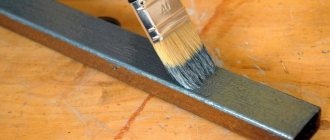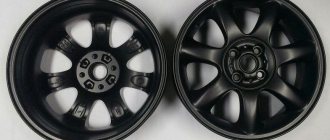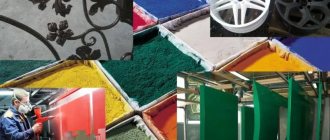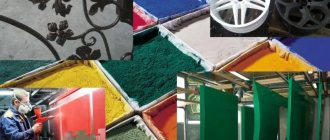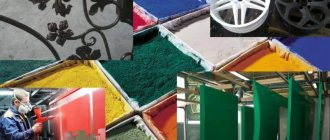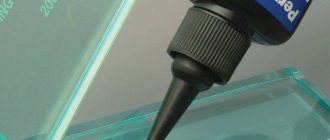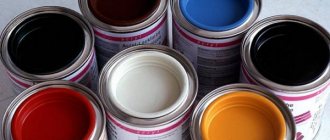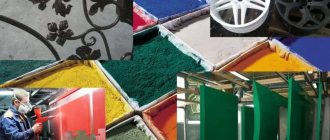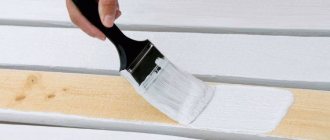A popular way to decorate wooden and metal surfaces is painting . The review presents various types of industrial coatings, an overview of their main properties. Experts will tell you whether it is possible to paint wood with metal paint. Not all compounds that reduce the risk of corrosion are suitable for wood treatment.
How to paint wood with spray paint?
Thanks to the metal balls inside, the contents of the can will become homogeneous. The paint is sprayed at a distance of about 30 cm from the surface. Apply the paint using smooth movements. Once the first coat of paint is applied, it must be left to dry for 20 minutes before applying further coats.
Interesting materials:
When do they want to cancel the UTII? When to glue wallpaper? When are carols in Russia? When to inject gonadotropin during the course? When does Ramadan 2020 end? When to dig onions 2022? When to dig carrots in the Urals? When did Korea divide? When to paint walls after priming? When will the crocuses bloom?
Previously painted or rusty iron: saved with Hameraite
Ferrous metal, barely touched by corrosion, does not require particularly careful treatment before painting, since Hamerite is not called rust paint for nothing. Red stains that have not yet begun to crumble do not require thorough cleaning; you just need to treat the surface with Brush Cleaner & Thinners solvent/cleaner of the same brand, and you can start painting. If rust has seriously begun its dirty work, turning the iron in places into a flaking, friable substance, it is necessary to clean off everything that is flaking and crumbling, otherwise, within a year, the paint will fly off along with the corroded layers. In addition, old surfaces are usually very dirty and, if the dirt is not removed, this will also cause the coating to quickly become unusable. In this case, it is advisable to prime the iron with Special Metals Primer before painting.
Previously painted iron is put in order in the same way as rusty and dirty iron - everything that can be cleaned is cleaned off using sandpaper, metal scrapers and brushes, and then treated with a solvent. There is a small nuance - although Hammerite paint fits well on previous layers of most types of paintwork materials, there are materials with which it is incompatible. These are powder paints and bitumen-based. It is not always known what exactly the structure was painted with previously, so you should conduct a compatibility test - treat a small part and wait for some time. If no “cataclysms” in the form of wrinkling, spreading, or the appearance of suspicious spots occur, you can safely begin to restore the object. In case of incompatibility, you will either have to abandon the idea of using Hammerite metal paint, or very carefully, completely clean the surface of the old coating.
Hammerite on previously painted wood: why not?
If you came up with the idea of using rust paint as a decorative coating for wooden buildings and objects, why not? The process of treating old and painted surfaces is practically no different from similar actions in relation to iron, with some differences. Peeling paint should be cleaned in a gentle way - with sandpaper and carefully, do not do this with a metal brush. Wood is a fairly soft material, especially compared to metal, so a brush can leave noticeable scratches and damage on the surface. After the cleaning procedure is completed, the wooden product, walls, fence, etc. should be washed and dried.
Necessarily! Before the Hammerite paint lies on the prepared surface, do not forget to treat the unprotected areas of the wood (after stripping the old coating) with a special primer that protects it from blue stains and mold. You can also use primer No. 1 Rust-Beater from the same manufacturer as an impregnation. The paint can be applied to surfaces previously painted with acrylic, alkyd, urethane and similar paintwork materials; there is no compatibility with bitumen and powder materials.
Hammerite metal paint is suitable not only for painting external surfaces; you can decorate any base located indoors. Depending on the effect you want to see, you can use hammer enamel that imitates chasing, smooth, matte or semi-matte. Apply at least two layers, maximum four to five.
Selection criteria
Some experts believe that color affects performance. Dark colors increase the heat transfer of the device, while light colors slightly reduce it. Now the choice of coatings is very large: there are separate products specifically for radiators; you can also use various enamels, heat-resistant varnishes, and water-based paints.
However, each type of coating has its pros and cons. So you need to carefully analyze everything before purchasing.
It is advisable that the heating be turned off at the time of painting work to avoid uneven drying of the surface, uneven application of the layer or loss of color. If for some reason this is not possible, you can use a coating that allows you to paint a warm surface.
The procedure for performing painting work
The technology for painting wooden products assumes that the work will be carried out in several stages:
- Selection and preparation of tools.
- Preparation and processing of the base.
- Painting.
- Additional processing (if necessary).
All processes are carried out carefully. It should be remembered that wood is a capricious material and is easily deformed.
Tool
For painting you may need:
- Spray gun and compressor. This system allows you to process large areas in a short period of time. At home, an alternative can be a mechanical sprayer.
- Brush. Necessary for painting hard-to-reach places, as well as for interior painting.
- Roller. It is better to choose a fur coat with medium-length pile.
- Convenient container. If you plan to paint with hand tools.
- Rags. To quickly correct errors.
- The process starts from the corner when working with walls, facades, floors and ceilings and from one of the ends when designing objects, furniture, and individual wooden elements.
- Oil and alkyd paints are applied using vertical strokes. Next, the composition is rubbed well, after which the movements become horizontal. Acrylic paints can be immediately laid horizontally (along the grain of the wood).
- The first layer is considered the base layer. To do this, the solution can be diluted slightly to ensure better styling. The second layer (if painting is done in three layers) creates a reliable base. After this, in places of defects, the surface is ground with fine abrasive. The last coating is applied most carefully.
- Spraying tools make it much easier to work over large areas. But when using them, the movements should be uniform and at the same distance from the base.
Oil type
The base uses oils, drying oil and dyes. Often used for painting metal in heated and unheated rooms. It has a high elasticity and hiding power. The coating is even and smooth. They take longer to dry and are produced according to GOST.
Often used for painting metal in heated and unheated rooms.
Is it possible to paint a battery in an apartment with acrylic paint?
The process of painting a heating radiator is often accompanied by the question of whether it is possible to paint the radiator with acrylic paint. Is it possible to paint hot batteries? What paint and varnish product is better to choose for a heating radiator?
Painting the heat exchanger is often an essential part of a renovation, although it can simply be a design move to bring a pop of color into the home. They are also tinted as the current top painted layer wears out, or they are simply painted with patterns on top of the existing one. Regardless of the type and volume of work, it is better to approach the choice of means responsibly.
Features of working with different types of paint
When it is necessary to paint with quick-drying paints, the surface itself must first be thoroughly prepared. The rapid rate of drying does not make it possible to correct shortcomings, so they are eliminated in advance. Even little things will appear through a thin layer.
When working with coatings that dry at a slower rate, it is preferable to apply the product in a thin layer, wait for it to dry, then apply a second layer. During drying, the paint manages to fill all the microcracks, which affects the evenness.
When it is necessary to paint with quick-drying paints, the surface itself must first be thoroughly prepared.
What paints are suitable for heating radiators
Our heating systems are unpredictable - the radiator can be cold, or it can heat up to high temperatures. And although most systems today operate at low temperatures, it is better to be on the safe side. Therefore, the paint for heating radiators must be heat-resistant - it must withstand heating up to 90°C. It should also be designed for painting metal.
There are universal compositions that meet these requirements, and there are special ones that say: “Paint for pipes and heating radiators.” If there is no large inscription, look for a similar line on the paint you like in the section where the area of application is described. If there is nothing similar, it is better to look for another option.
It must be indicated that the paint is suitable for painting pipes and heating radiators
What else you need to pay attention to is the presence of the manufacturer’s address and company name. There are many fakes on the market today. The label is very similar to some famous brand, but there is no address information. If this is the case, it’s better not to take risks - no one knows what’s in this jar.
Is it possible to paint radiators during the heating season?
The fundamental factor for high-quality coloring is the surface temperature of the heating device. It is not recommended to start painting heating radiators connected to the heating network, because paint applied to a metal surface heated to a temperature above 60°C dries quickly, not providing the required density, and uneven coloring may also occur.
In winter, it may not always be possible to properly ventilate the apartment. At the same time paint applied to hot metal emits a strong odor that is difficult to get rid of for a long time. Therefore, it is better to start the process of painting batteries in the summer, when it is possible to organize natural ventilation and the surface of the radiators is at room temperature.
How to paint radiator in winter, during the heating season? In this case, you need to choose the right coloring composition. It is recommended to use oil-based materials without fragrance, or special types of water-based paints.
Aerosol paints are distributed more evenly over a hot surface, while the coloring process occurs much faster than when working with a brush. Upon completion of work, you should ventilate the room, but do not allow a sharp drop in the temperature in the room.
The issue of colors during the winter heating period is discussed in more detail in this article.
Video description
The process of removing old paint from a cast iron battery using a remover is shown in the video:
The next stage is priming the surface. It is advisable to choose a composition for this on the same basis as the selected paint. For example, radiators under alkyd enamel can be primed with GF-021, which has an anti-corrosion effect.
Advice! Before painting a battery in a living room, you need to protect the floors, walls and nearby furniture from accidental paint on them - cover them with film, newspapers or packaging cardboard.
You can begin painting after the primer has dried. If it is done manually, it is advisable to use two brushes: one curved on an elongated handle for hard-to-reach places and a second regular one for the front surface. Both should have natural bristles.
This brush will allow you to reach the most difficult areas of the radiator Source gidpokraske.ru
Painting begins with the internal surfaces, leaving the façade for last. As a rule, a minimum of 2 passes is required to achieve a smooth and evenly colored surface. The second layer can be applied after the time specified in the instructions and necessary for complete drying.
Selecting a pre-treatment agent
A separate category consists of impregnations, which are necessary to improve the structure and durability of wooden elements.
Such mixtures include:
- Drying oil. It is applied to protect the base from any harmful influences. It is better to lay several layers to achieve deep penetration. Can be used before oil paints to reduce their consumption.
The oil is ideal for processing wood indoors with temperature changes and high humidity.
- Special antiseptics. Protect from microorganisms and insects, prevent rotting.
Fire-retardant composition for wood Phenilax
Important! Impregnation is carried out carefully and in advance so that the wood has time to absorb the required amount of the composition.
Surface preparation
The condition of the surface to be painted dictates the need for its pre-treatment. The following procedures must be carried out:
- Cleaning to remove irregularities, chips, burrs, protruding fibers and similar surface defects.
- Degreasing and removing dust to improve the adhesion of the surface to the applied paint and varnish composition.
- Preliminary application of impregnation in order to give the wood antibacterial, antipyrite (fireproof) and waterproof characteristics.


